http://theworkingdraft.com/
Previously on Baxter Building: Sure, the Marvel Universe as we know it has been created, and Stan Lee and Jack Kirby have done some wonderful things together. But this time around? This is when things get really good, trust us.
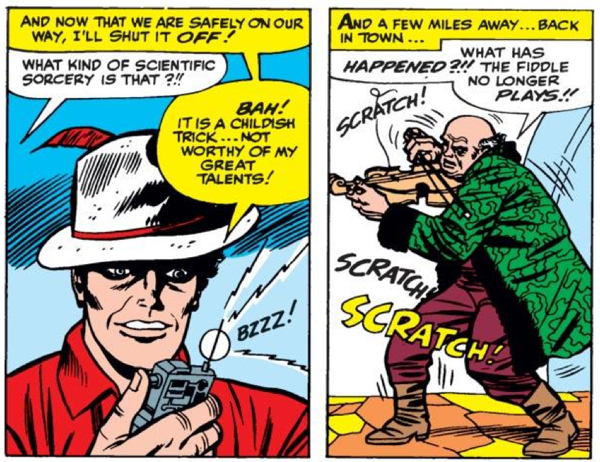
0:00:00-0:03:56: In which Jeff describes the task ahead of us this episode — namely, getting from Fantastic Four #36 to #48 in the time allotted (and not continuing on to #50, considering that FF #48 is both the end of the Inhumans story and the beginning of the Galactus story) — as “literally impossible,” which is, let’s be honest, a challenge. Spoilers: It’s one that we manage to accomplish, also sneaking in Fantastic Four Annual #2 and 3 in there as well, despite an unusual recording schedule thanks to my day job.
0:03:57-0:25:41: And we’re off, with our delayed conversation about Fantastic Four Annual #2, which has sadly suffered from being paired with this batch of issues as opposed to those we talked about last time. We start with the origin of Doctor Doom, which lets us talk about Jack Kirby’s interest in non-urban spaces, Young Victor Von Doom’s fashion sense, and whether or not Doctor Doom was really into magic or just a very big Arthur C. Clarke fan. Also, is Doctor Doom a really, really bad Batman?
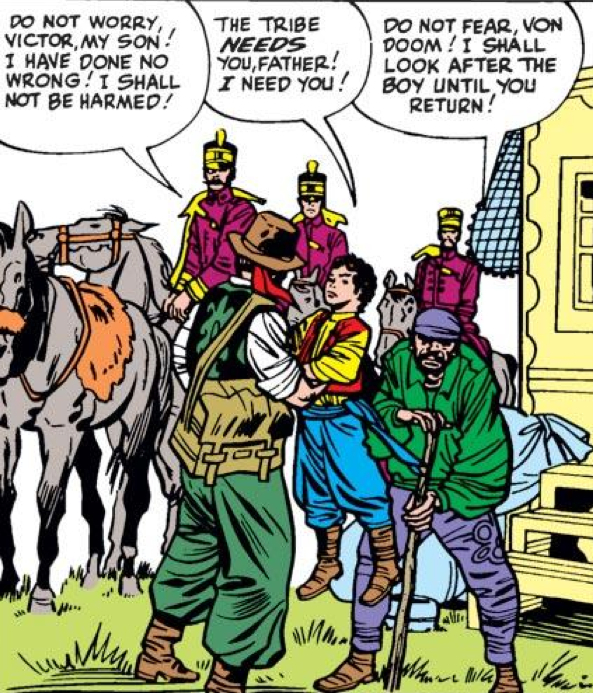
0:25:42-0:31:36: The second of the new stories in the annual isn’t quite as great as “The Fantastic Origin of Doctor Doom!” but what could be? Nevertheless, “The Final Victory of Doctor Doom!” has its own charms, despite being what Jeff calls “a little bit of a mess” (Maybe we should chalk that up to Stan Lee and Jack Kirby being somewhat hyperbolic and out of synch again, though.) There’s some really great stuff here, including Doctor Doom’s vanity and why recycling would have made all the difference for the world of Victor Von D. (We get distracted by events, and sadly didn’t get a chance to properly talk about the Fantastic Four getting roofied as plot device, which… I mean, wow.)
0:31:37-0:33:30: A slight interlude. A patented Baxter Building No-Prize (which is to say, no, really, no prize) to whoever can name the music in the background.
0:33:30-0:35:45: A little bit of meta-commentary about music (Contrary to what Jeff suggests and what I got so excited about, I obviously didn’t use “The Girl From Ipanema,” mostly because I couldn’t find an instrumental version I loved). Turns out, I misremembered the Captain Scarlet theme, which actually sounds like this:
It’s actually far more wonderful in this version, I have to say. Oh, and we’re both serious about wanting cover versions of our theme music, all you musicians out there.
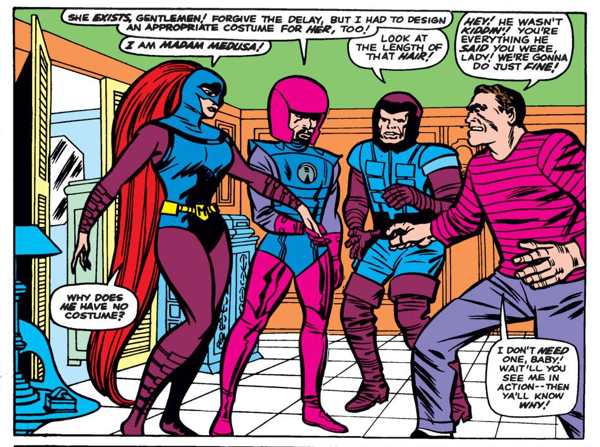
0:35:46-0:47:36: Fantastic Four #36, also held over from last episode, feels very much like the first part of the next era of FF in terms of plot, if not aesthetic, thanks to the debut of (Madam) Medusa and a focus on the upcoming nuptials of Reed and Sue. Is this, as Jeff suggests, the most Stan Lee era of the Lee/Kirby FF? Perhaps, which might explain the fact that it’s also the first time that villains from another series altogether turn out to be central protagonists to the series. Curse you, ever-growing Marvel Universe (but hello, Wingless Wizard, Sandman and Paste-Pot Pete)! Also discussed: Our mutual love for the Sandman and the potentially-unintended subtext to the Frightful Four, including why they’re not the Super Apes.
0:47:37-0:50:12: Is Jack Kirby leveling up with every issue by this point? You bet your ass he is, and we talk about that for a bit. (We’ll come back to it later, when the book switches inkers, don’t worry.)
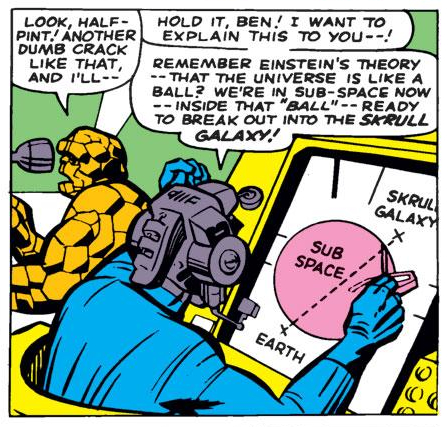
0:50:13-1:00:00: “Behold A Distant Star” in FF #37 sees the FF invade another galaxy because… Sue’s had significantly delayed grief about the death of her father issues earlier, apparently. Or maybe it’s Jack Kirby’s fault, as we’ll suggest (Jeff introduces the concept of “active continuity” here, which we might return to in future). Also, the Skrull menace is finally dealt with, and we never ever hear from them again, right…? All this and Stan Lee and Jack Kirby explain how space travel works, and I suggest that perhaps the series was happening too quickly for its long-term good at this point. The lack of long-term planning on the book is also discussed in passing, especially when it comes to Jack Kirby’s plotting and Stan Lee’s inability to parse out what is about to happen, and we talk about whether or not this was originally intended to be a Skrull story at all.
1:00:01-1:03:21: We reach my favorite letter in this entire run of issues, as Stan Lee deals with an actual Communist. No, really.
1:03:22-1:18:31: The Frightful Four return in Fantastic Four #38 as the series shifts into an era of endless narrative, where stories just lead in and out of issues as necessary, without a need to obey constants of issue length. We talk about that, and also about the obviously re-written dialogue that ensures that children of the 1960s didn’t see Ben Grimm threaten to spank Sue. Except that they obviously did:

Jeff explains which Reed Richards is his left favorite, we talk about Stan Lee’s problems with female agency and the ways in which the story’s pace keeps the reader onboard despite some fairly obvious problems. The ending of the issue, in which the FF survive an atomic blast, comes under discussion as well, as I wonder about the similarities with the famous death of the Doom Patrol (which happened years later, something I wasn’t sure about when recording) and Jeff wonders if this is the first time that an audience had a cliffhanger that ensured that they knew that the heroes had survived such an explosion.
1:18:32-1:25:07: Here’s a mea culpa — I say that FF #39’s “Frankie Ray” is Frank Robbins, but I’m entirely wrong: It’s actually Frank Giacoia. Too many Frank pseudonyms for my own good. Either way, goddamn, those are some amazing inks, and the series looks as good as it’s looked to date. In what’s almost a timely moment, Daredevil shows up in the series as Doctor Doom attacks. Oh, and the Fantastic Four are powerless (again!), which leads to this new temporary new look for the team:
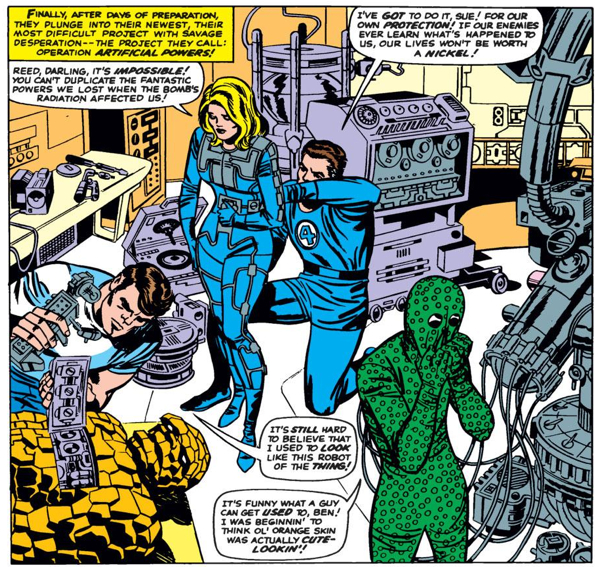
Man, how I wish they’d kept that status quo for longer. Kirby’s Daredevil is admired, but because it’s part one of a two-part story, we quickly move on to…
1:25:08-1:40:06: … FF #40, “The Battle of the Baxter Building,” in which Reed Richards is such a dick to Ben Grimm that it launches him on a murderous rampage that’s one of the most thrilling, visceral sequences in the series so far. That’s despite the appearance of Vinnie Colletta, showing up for the first of a few issues of inking and kind of making Kirby’s art look that little bit less impressive. But not even Colletta can ruin this:
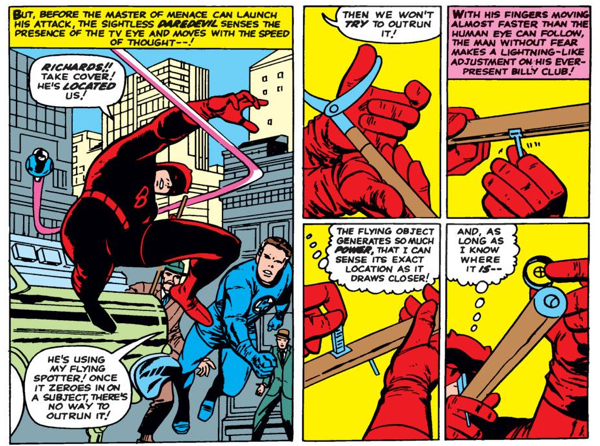
The Thing’s rampage against Doctor Doom, however, remains the highlight of the issue, however, and Jeff makes a case for it actually being a Thing/Mr. Fantastic fight, albeit in a way that neither Lee nor Kirby were properly aware of at the time. And where was the rest of the team while all of this going on?
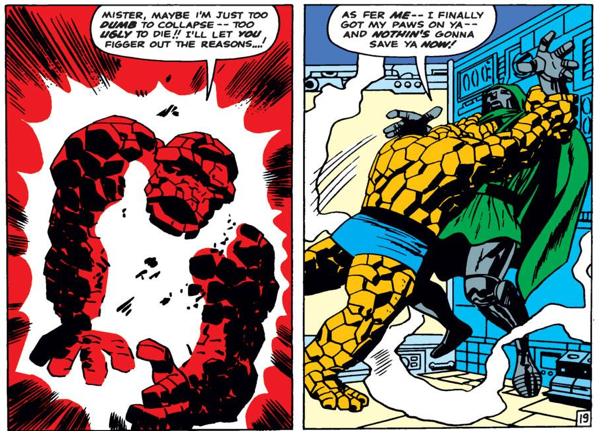
1:40:07-1:50:44: The 41st issue of Fantastic Four has a pleasingly ambiguous title: has Ben Grimm been betrayed, or is he doing the betraying? It’s one of a number of questions we talk about, with the others including whether or not Alicia is the latest victim of the passive aggressive battle between Lee and Kirby, and whether or not Madam Medusa is the FF’s forgotten top femme fatale. Jeff also reveals the best reason why Medusa acts out of character in these first appearances, and we marvel at the spectacular death traps the Wizard creates for the team. And for those reading along, if you’ve been wondering about the Thing’s dental work, prepare to get excited.
1:50:45-2:00:09: Is “To Save You, Why Must I Kill You?” the most perfectly passive aggressive story title in comics? Possibly, but it’s just one of the many thrills on offer in FF #42, which turns out to show all of the characters (with the exception of the Thing, who’s mind controlled) at their best in some way or another. Is this an issue that shapes the future of the Marvel Universe (and especially Roy Thomas’ Avengers)? Possibly — leading Jeff to suggest that other, lesser, artists would quit as soon as they hit these points, but Kirby was only getting started.
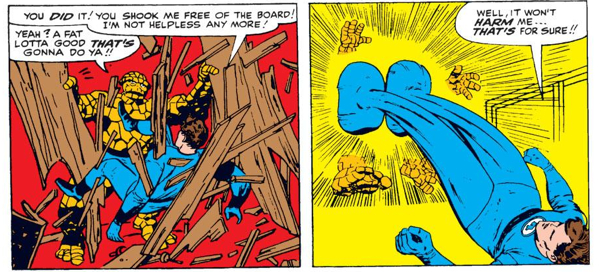
2:00:08-2:02:59: After what we’ve said about the first two parts of this storyline, we kind of don’t have that much to say about FF#43, “Lo, There Shall Be An Ending,” but that doesn’t mean it’s a bad issue, just one that’s overshadowed by what’s come before.
2:03:00-2:08:27: How is Fantastic Four Annual #3 like Secret Wars? Jeff explains all, while trying to convince me that it’s better than I think it is (My problem is really that it’s almost entirely a reprint book).
2:08:28-2:16:39: Fantastic Four #44 is a big issue in a lot of ways — Joe Sinnott joins the book as inker, Medusa gets a reboot and the Inhumans get properly introduced (Well, in some ways). There’s also Reed Richards’ greatest invention to date:
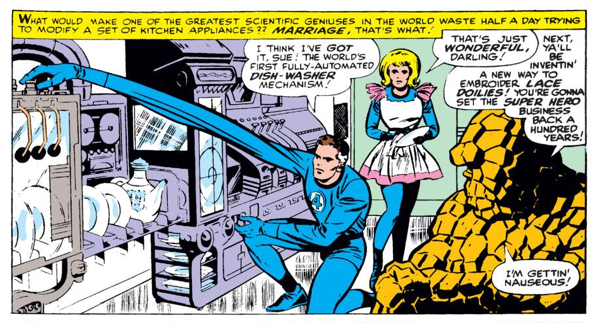
The newly-domesticated Sue Richards is introduced in this issue, and — well, if you thought she was a less-than-independent character before, you ain’t seen nothing yet. Is Joe Sinnott redrawing Kirby? Is Dragon Man really necessary here or anywhere else? Both of those questions will be… maybe not answered, but definitely raised.
2:16:40-2:24:16: “Among Us Hide… The Inhumans” in FF #45, and Jeff and I completely fall under the spell of the Inhumans, thanks in large part to the way they’re introduced slowly and independently of each other. Johnny Storm’s predilection for wandering around the bad parts of town is raised as an area of concern, but we forgive him because it means we get to meet Crystal and launch into one of the stranger — but surprisingly potent — romances of the Lee/Kirby era.
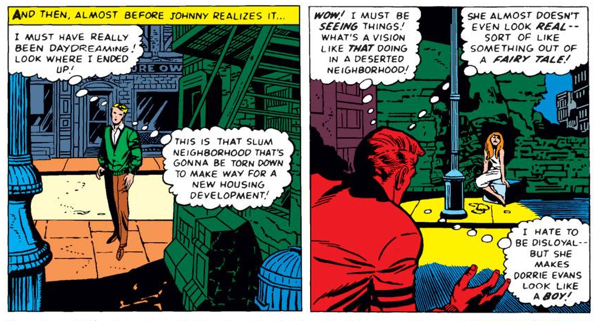
2:24:17-2:32:33: There’s a lot going on in FF #46, including the need for Reed Richards to increase security at the Baxter Building, Stan Lee yet again being caught out by Jack Kirby’s plans for future issues, and Jeff really, really making me wish that Kirby had designed Yellow Submarine for the Beatles. (I’d like to point out that, for once, it’s not me coming up with these 1960s pop references. Okay, sure, I did make the Who one earlier.) Continuing a theme of this episode, Kirby’s mastery of pacing is discussed, as well.
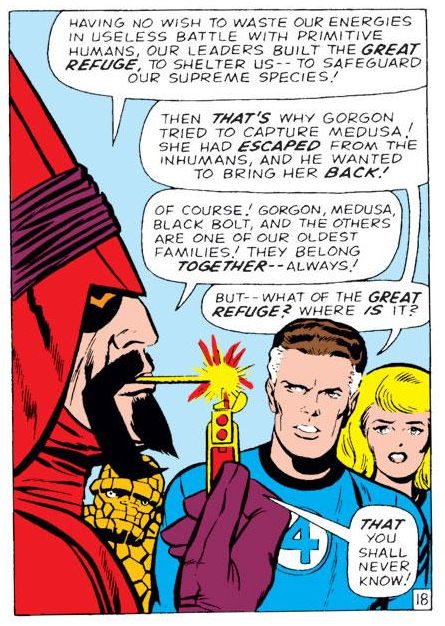
2:32:34-2:39:59: We near the end of the episode, and the end of the first Inhumans storyline, with Fantastic Four #47, but not before we make it through the first appearance of Maximus The Magnificent, who genuinely appears to live up to that description for all of about four pages. Who says this isn’t the Mighty Marvel age of incredible designs for disappointing characters, following the previous issue’s Seeker? We return to the question of the Thing’s teeth, and the subject of how weightless the reversals and reveals in this era of Fantastic Four are, and the way in which it doesn’t matter because Kirby manages to overwhelm common sense by sheer willpower. (“Don’t ask — just buy it!” indeed.) Also, the question of who called Black Bolt the first pure Kirby creation was, I remembered post-recording, Elle Collins in the Into It episode I guested on, so now you know. (Also, Stan Lee comes up trumps with the Johnny/Crystal romance in this issue, as far as I’m concerned.)
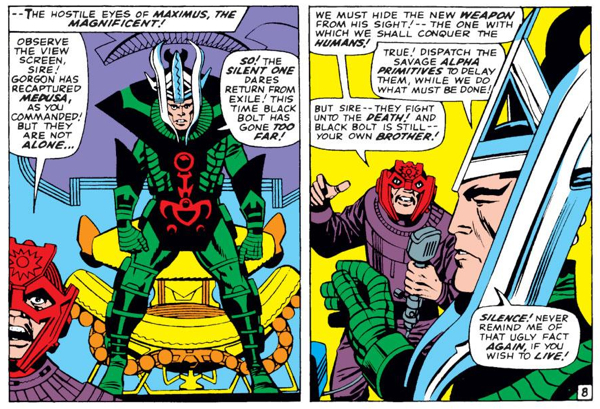
2:40:00-2:46:45: Even though the cliffhanger at the end of #47 turns out to fall flat on its face in Fantastic Four #48 — something Jeff politely suggests might have been down to miscommunication, and not just an utter failure of a plot device — there’s actually a surprisingly strong conclusion to the Inhuman storyline in the first pages of the issue, and it’s all thanks to Stan Lee. Who saw that one coming?
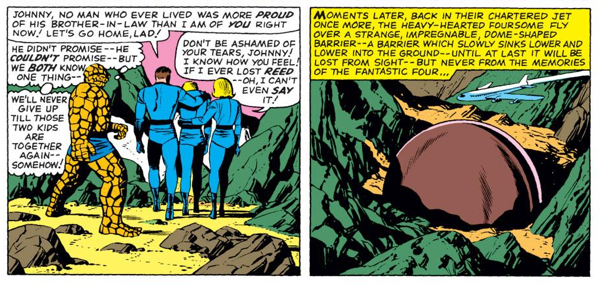
2:46:46-end: We wind everything up and tell you about what’ll be happening in the next episode of What, What?, as well as what issues we’ll be reading next Baxter Building. If you’re looking for us before then, you can find us on Tumblr, Patreon and Twitter. As ever, if you’ve made it this far in the show or the show notes, thank you very much for paying attention. We love you almost as much as Reed loves Sue, only without the constant need to put you down at any given opportunity. (That said, you’re going out in that?)


Great ep, as usual gents. Will you post that Bullpen article Jeff mentioned with Stan’s passive aggressive slam on Jack?
I’m really liking the discussion of inking. When I was reading the Fourth World stuff in my late teens, I didn’t really understand why Colletta was considered the “bad” Kirby inker to Sinnott’s “good” Kirby inker. Reading these FFs now and listening to you talk about inking on the podcast, it’s abundantly clear where these reputations come from. I find it hard to read FF Annual #3 now with those inks.
Speaking of which, I’m a bit bummed you didn’t mention the laugh-out-loud Spider-Man cameo in Annual 3, which is clearly a sticker of Steve Ditko’s Spider-Man pasted in at the last second. I mean, at least with Superman, they only redrew the face.
Jeff posted the thing he mentioned over on Tumblr: http://waitwhatpod.tumblr.com/post/116484978509/from-fantastic-four-37-this-letter-was-mentioned (along with a mea culpa, because he didn’t remember it exactly.)
And I didn’t even NOTICE the Ditko Spider-Man! I need to go back and re-read!
Thanks for the link. Gotta remember to check out that tumblr from time to time. By the way, in case you’re curious, the source for the Spidey swipe is ASM #19 page 13 panel 4.
A great insightful podcast guys! I’m following along with my B&W essential volumes.
You mentioned how sleek Daredevil looked in FF #39. That’s because he was ghost inked by Wally Wood who was putting his definitive stamp on DD at the time. He only inked DD in that issue and not the next.
I believe Jeff referred to that beautiful panel of Medusa in FF #44 – (11/65) page 4 panel 3 started to link the asthetics of Kirby and Romita together into a house style. At that time, Romita hadn’t drawn his first Spidey yet (#39 – 8/66) or even his Daredevil try-out two-parter (with Spidey) (5/6-66). He may have only drawn a handful of Marvels (if that) at that point in time. I do agree that the arrival of Sinnott did signal a sleeker/less gritty Marvel house style was on the horizon and yeah, Sinnott made Kirby’s faces a lot more pretty. He also probably smoothed out Kirby’s knack for drawing some characters “off model” from issue to issue (his Sandman looks all over the place to me).
Those Colletta inked issues are truly godawful!
As to the gray coloring of Gabe in the wedding issue. Marvel was pretty progressive in the early 60s by including African American characters here and there and for whatever reason, they were colored gray. It was still going on by the time the FF went to Africa where Kirby introduced the Black Panther in FF #52.
OOO, thank you for mentioning Wall Wood’s part in that issue—I didn’t know that, but it made sense as soon you mentioned it. And a great point about Kirby and Romita aesthetics: now that you mention it, I totally associate Medusa with John Romita thanks to all the work he did during the ’70s when she was one of the very few Marvel heroines and therefore got a certain amount of promotion.
also – pedantic but – Frankie Ray was Frank Giacoia not Robbins
Thanks, Simon! Graeme corrects himself in the show notes (which is a thing I’m tempted to do, but would render our show notes almost 100% me correcting myself).
missing notes is one of the perils of reading on a small phone screen I guess! A spiffing episode tho, chaps – took me right back to a childhood reading the reprints in Mighty World of Marvel
In regards to Graeme’s comment on Stan’s reply to David Cockrum’s letter, I think the “homophobic” descriptor is modern, internet-y analysis that avoids Occam’s Razor. Stan didn’t want a bunch of military guys reading “Millie the Model” not because he didn’t want them to be/become queer, girly men, but because he didn’t want a bunch of sex-deprived men jacking off to a Marvel character. Contrast that with not 30 years later the same company publishing swimsuit issues for that im/explicit purpose.
Jeff’s theory about Medusa is actually later Marvel canon and one of my favourite ret-cons. Jeff Parker and Karl Kesel employ it in X-Men First Class #15, which is a continuity implant that fits in between FF#43 and #44.
I like it that the Wizard helps Medusa with the designs for Sue’s wedding dress as it goes with his passion for re-vamping and costuming the Frightful Four. He really cares what they look like. The Frightful Four will pop up again as individuals, but don’t return as a team until FF#94, which is last great issue in their run IMO.
It’s interesting seeing Sinnott learn to ink Kirby so that he doesn’t compete with what Jack’s doing and instead shows it to it’s best advantage. Chic Stone’s beauty lies in being the closest thing we get to inking-a-Kirby-as-is inker that we get until Mike Royer.
I’m listening again and two thoughts occur. Doom doesn’t return to previous plans, because improving them would involve acknowledging they weren’t perfect the first time. Also, as a child I was tremendously affected by both Spider-Man lifting the heavy machinery and Ben’s battle with Doom. I think they’re regarded differently because Peter faces despair and overcomes it because of his love for and connection to people. Ben is unstoppable because Reed has made him a thing, not a person. He’s furious, but he’s utterly reckless with his life because he’s been made to feel he doesn’t matter, he’s utterly alone, a man without anything left to lose. His is the strength of despair. Hey, thanks for letting me understand one of my favourite scenes in comics and contrast it to another.